
This corner in downtown Winston-Salem has a 1929 third scale version of the Empire State Building in the vacant Reynolds Tower, a 1966 curtain wall office tower and an also vacant classical courthouse. Both the 1966 skyscraper and courthouse are listed in the National Register.
My last posting was a plea to stop viewing everything as black or white – architecture, politics, life. The last sentence in that posting was, “So, while green has been the color of the decade, maybe gray should be the color of the next.“ And now I think that’s the perfect sentence to start off this essay with.

Historic Salem Square in Old Salem is surrounded by an active college, museum exhibit buildings and historic residences. Together they tell a complex and nuanced story.
As many of my regular readers know, I have had the great fortune of living in five fabulous cities in my life – Buffalo, NYC, Seattle, Washington, DC and Winston-Salem, NC. Each one is different; each one tells a different, important part of America’s story. Each one makes me happy in different ways. Buffalo represents my family core and the location of some of the greatest architecture in America. New York City’s visual chaos and aural cacophony inspire me and wake me up with every visit. Seattle reminds me of the delight we can find when we juxtapose sublime nature with man-made innovation. Washington balances beaux-arts city beautiful planning with elegant new green thinking and the sadness of sequestration. And Winston-Salem, with its hyphen, represents how a modern city can flourish by acknowledging its founding Moravian fathers, its tobacco-funded growth and most recently its banking revival. Each of these cities struggles with its past. But I believe it is this struggle that makes them and us richer and more fascinating. If only everyone thought that way.
Complexity of The Discussion Leads to Stereotyping
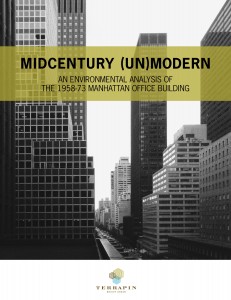
This study by Terrapin Bright Green entitled “Midcentury (Un)Modern” is pitting real estate professionals against preservationists.
A new piece of research was published last week on the energy efficiency (or lack thereof) of midcentury modern office buildings in Manhattan. And the interpretation of that study is drawing that perpetual line in the sand. Crain’s NY strongly states that this study can now give carte blanche to owners and developers to demolish all midcentury office building and replace them with new “greener” versions. And hallelujah for that, they claim. The Preservation Green Lab argues that an understanding of the study needs to be far more nuanced. And The Atlantic Cities falls somewhere in between.
We seem to have lost the ability to recognize and acknowledge nuance. We make sweeping statements of condemnation or value and draw lines in the sand that lead to a lack of dialogue or balance. We impose our own opinions and jump up and down with our hands covering our ears so we don’t hear our neighbor’s response. It’s either green and energy efficient or it’s not. It’s beautiful or it’s not. It’s historic or it’s not. You’re a preservationist or you’re not. You believe in climate change or you don’t.
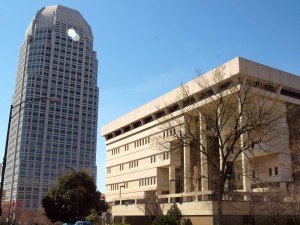
Cesar Pelli’s 34-story 1995 tower overlooks Winston-Salem’s city hall whose design was based on the much-maligned Boston City Hall. Boston hates their city hall, Winston-Salem loves theirs.
Because these discussions are so complex, it is much easier for media outlets like Crain’s to just make a broad-brush statement – some midcentury modern buildings are inefficient therefore they all should be demolished. Anyone who thinks this Crain’s article is not specifically targeting midcentury modern in the midtown east neighborhood because of the Bloomberg administration’s new suggested policy of increasing density in this area, is delusional. Crain’s is by real estate professionals for real estate professionals.
How do we balance what we respect from the past with what we commit to the future?

Of this row of the four oldest houses in Old Salem, only one is original. The others are restorations and reconstructions.
I heard a comment on NPR this past weekend that resonates, “It’s hard to embrace brick and mortar, people relate to stories, the story of the place.” And when that story is difficult, or horrific, it is even harder to embrace the place. It is easier to revise the story or ignore it. I read an article in the Winston-Salem Journal this week about the controversial placement of the Confederate flag in the North Carolina State House as part of an exhibit on the 150-year anniversary of the Civil War. The article just shared the usual for and against Civil War history rhetoric. “Many people see the flag as a potent reminder of racial discrimination and bigotry.” Well of course, that is part of the story. History is messy, it is uncomfortable, it is nasty. But if we ignore it, then we do ourselves a huge disfavor. We forget and dilute our stories. One of my former National Trust colleagues and Facebook friends posted this weekend that someone told a colleague of his that his recent speech on slavery was depressing. And another friend commented, “Reality is a real bummer for folks who have OD’ed on an excess of “moonlight and magnolias”. The truth ain’t always pretty and sometimes it is ugly as sin but it will set you free.” Amen to that.
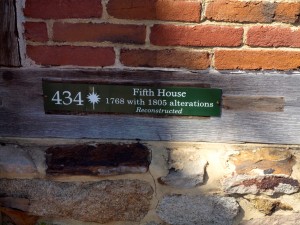
New signage on all the buildings in Old Salem tells their story – original, restoration, alterations or reconstruction. There’s no pretending here.
One of the places that I think has struck a balance between telling the story of its past, not always pleasant, is Winston-Salem, NC, particularly Old Salem where I live part-time. It hasn’t been easy getting there, but more and more the story that is presented through its exhibit buildings, through the living of its citizens and the remembrance of its religious and multi-racial past through lectures, exhibits and targeted restorations, is balanced and informative. The historic town itself is a National Historic Landmark, known for its restorations and reconstructions. I find it one of the most authentic historic sites I’ve been to, because it doesn’t pretend. Every building has a sign on it that tells if it’s original, restored or a reconstruction. Only twelve of the 112 buildings are exhibit buildings, the remainder are still lived in. The historic black church has been restored and is still used by its congregation for special occasions.
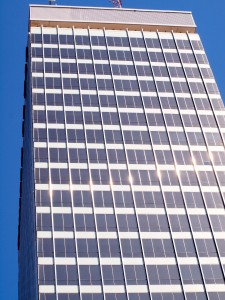
Should only the National Register listed midcentury modern office towers like the Winston Tower in Winston-Salem be saved from the wrecking ball?
The adjoining city of Winston, which was connected to Salem in 1913, giving the first and still only hyphenated city in the country, Winston-Salem, has an interesting combination of buildings from every era, including a one-third scale “Empire State building” which was the Reynolds Tobacco headquarters, a city hall whose design was based on the much-hated “brutalist” Boston City Hall, a 34-story postmodern Cesar Pelli tower built in 1995 and a 1966 curtain wall office tower, Winston Tower, that is listed in the National Register and is a successful rehabilitation investment tax credit project.
Will the phrase “demolition by neglect” be replaced with “demolition by (lack of) energy efficiency?”
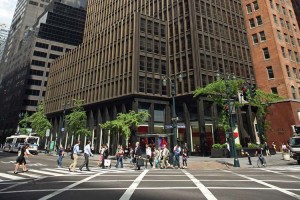
The Midcentury (Un)Modern case study, 675 Third Avenue, designed in 1966 by Emery Roth. Photo courtesy Durst Organization website.
An actual reading of the Midcentury (un) Modern report does of course present a much more nuanced review of Manhattan’s midcentury office buildings. Some buildings are better suited for retrofits than others. Some buildings are more efficient than others. Some use more electric than others, some use more gas. Only one building was used as a case study, 675 Third Avenue (a 1966 Emery Roth building). To quote the conclusion: “Using a representative building as a case study, we have demonstrated that it is possible to increase commercial occupancy in Manhattan while using less energy on an absolute basis. The example analyzed here suggests that significant energy savings are locked up in a segment of obsolete office buildings, which are not only inefficient but also have lost commercial value in the last fifty years.” Now I’m no statistician or scientist, but basing a conclusion for an entire era of buildings by studying just one, does not seem very scientific or justifiable. The report does indicate that architectural icons like the Seagram Building and Lever House should not be included in this broad-brush review. And certainly the NY Landmarks Conservancy and Historic Districts Council have been battling the mayor’s density suggestions for the area surrounding Grand Central Terminal.
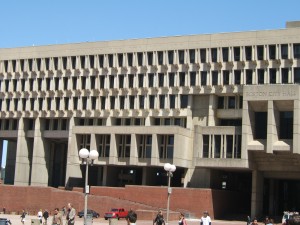
Some people don’t like “brutalist” buildings like Boston City Hall. Some now think they’ve been given carte blanche to demolish midcentury modern office buildings. Will we lose an entire era of our history because it’s too difficult to keep them?
So, as if we don’t have enough trouble with challenges to midcentury buildings, now we are being told we should use their (perceived) lack of energy efficiency to validate their wholesale destruction. Some are highly unpopular (Brutalist examples). Some were absolutely ill-made. Some may be highly energy inefficient, but their inefficiency in many respects is because we do not maintain or operate or retrofit them properly. This issue of energy inefficiency of midcentury modern buildings has long bothered me, but as one audience member of a recent talk I gave on the preservation of modern said, “a good architect can remake any type of structure.”
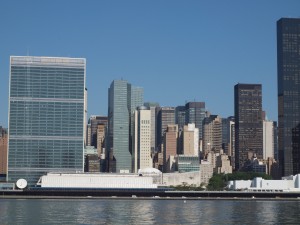
The United Nations has chosen to renovate its midcentury modern complex on the East River in Manhattan.
I find it incredibly hard to believe that the demolition of millions of square feet in Manhattan alone and the replacement of those buildings with taller, bigger, denser “green” skyscrapers would improve greenhouse gas emissions in the long run. We still have two basic problems – adding to the landfill and the inefficient operation of our buildings. Designing a new building to LEED platinum does not indicate at ALL that the operation of that building will be any better than the building we replaced, because it is still maintained and operated by us. And we just can’t seem to operate our buildings to their design levels. The problem isn’t the buildings, it’s us.

This 1839 historic house in Old Salem is currently undergoing a restoration. We all love red brick Federal buildings. But what if they were the only buildings we could agree on keeping? What story would that tell about us?
For decades we’ve been losing sound buildings and landmarks from “demolition by neglect” – owners not maintaining their buildings to the point of demolition, they’re in such bad shape now, they need to be removed. So, now we need to worry about owners claiming their new building will save the planet because it will be so much more energy efficient. Everyone seems to think the answer to green is black and white. But the answer is not in the broad-brush approach, it’s in the nuance which is gray. And no one wants to hear that. Removing whole eras of buildings and their cultural story is not the answer. The answer is operating and retrofitting all of our buildings better. And that’s just good green business.
And if you’d like to “subscribe” or follow my blog, True Green Cities, please sign up through the “Subscribe” button at the bottom left of this page. You’ll receive a daily recap when new blogs are posted. Or Sign up for the Feed.
